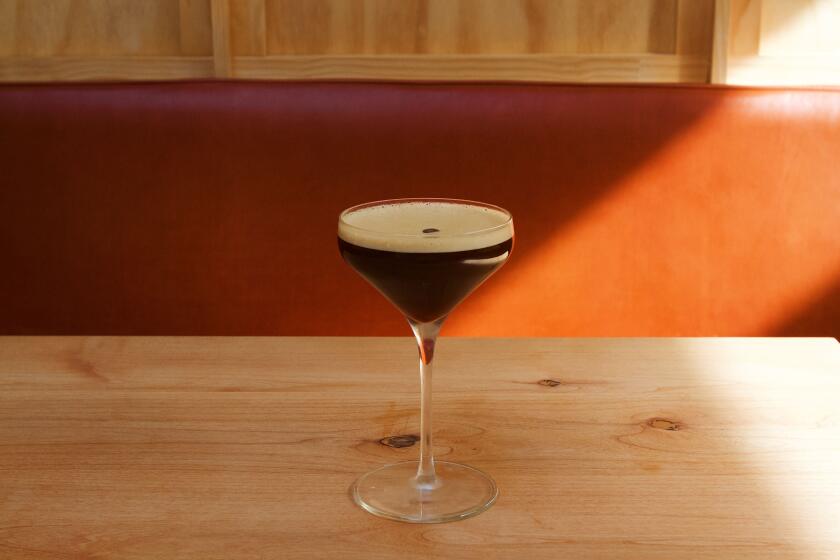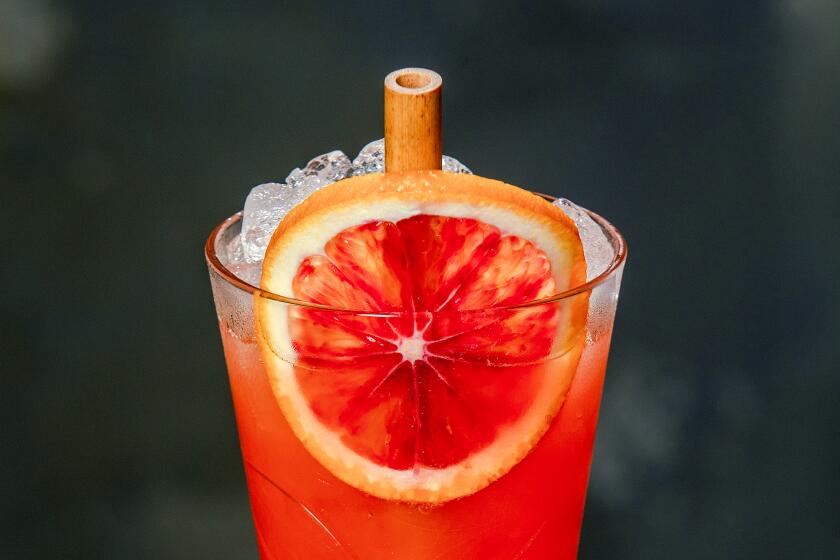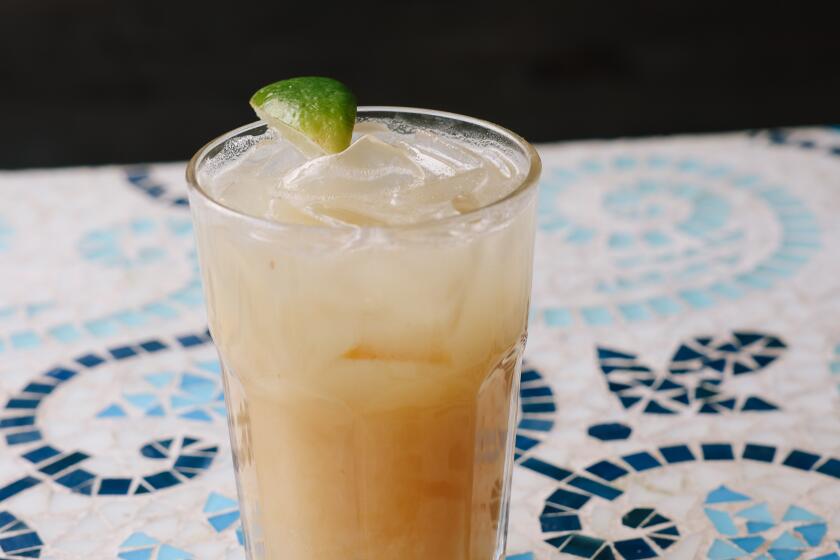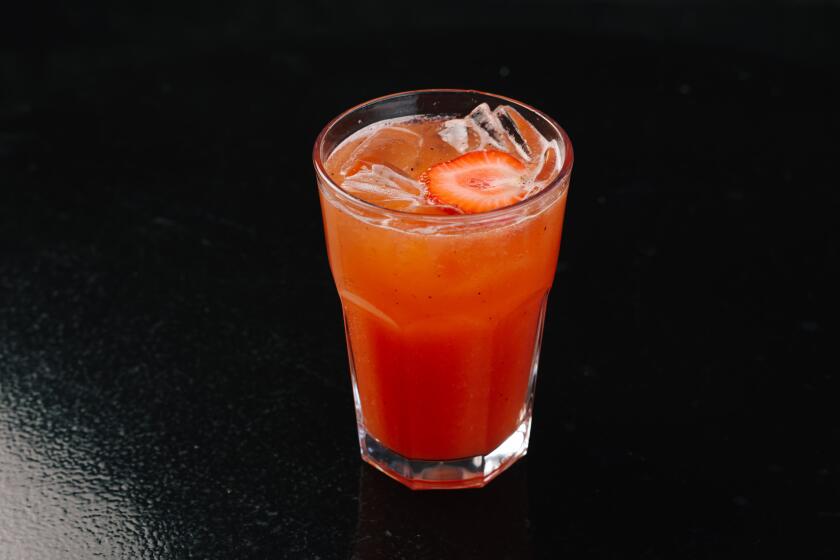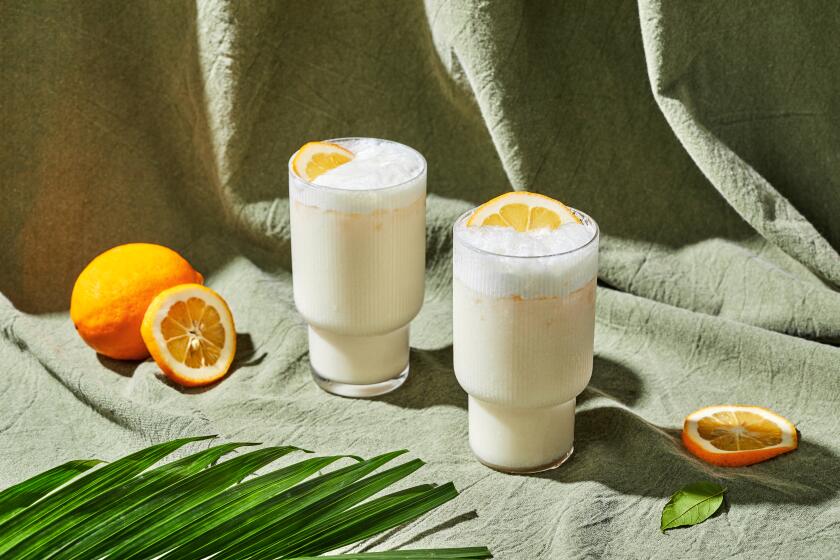Montresor & Fortunato
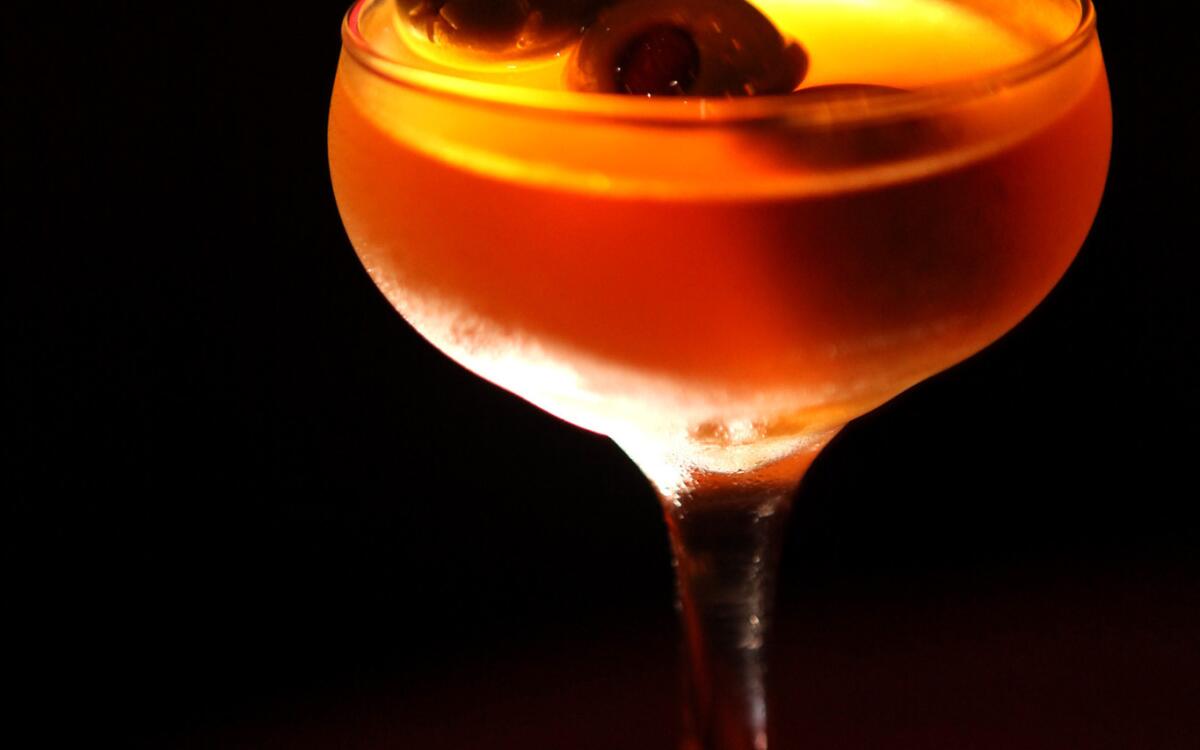
- Share via
Sherry cocktails have come a long way from hot sack posset. A custardy Middle Ages concoction of sherry, milk and eggs, popular first in Britain and then the New World, sack posset eventually gave way to the likes of the 19th century Bamboo, a combination of sherry, dry vermouth and orange bitters invented by a German bartender in Yokohama, Japan, and introduced to the U.S. by William Boothby’s book “World’s Drinks.”
Then something (Prohibition, bad marketing, corporate consolidation, you name it) happened on the way to the 21st century, and the market for sherry -- the lovely fortified wine from Spain -- was relegated to cooking wine and low-quality sweet stuff. And that was that for sherry cocktails.
But here and now on La Brea Avenue, there’s plenty of evidence of the sherry cocktail’s resurgence. At the just-opened Tar Pit, co-owner/bartender Audrey Saunders recently was behind the bar perfecting her roster of sherry cocktails. There are four on her menu of about 20 drinks, including a house aperitif of apple-infused fino sherry wryly called All About Eve.
Sherry’s distinct, maderized flavor, characterized as a tangy nuttiness, makes for elegant, edgy, savory cocktails. Gin, rum, whiskies and “interesting modifiers” such as Chartreuse or amari already are a well-established part of the mixologist’s canon, but sherry is finally an up-and-coming cocktail ingredient at bars in L.A.
Lately you’ll find at least one sherry drink on menus at some of the places heavily frequented by cocktail enthusiasts, such as Rivera downtown and Copa d’Oro in Santa Monica.
At the Bazaar by Jose Andres in the SLS Hotel in Beverly Hills, beverage director Lucas Paya created a shimmery, bubbly drink called the Golden Boy that’s perfect for a New Year’s Eve party. It’s amontillado sherry and Cava (“the two best wines for food, ever,” according to Paya) with a dash of orange bitters, a hint of lemon and a little gold dust.
And at the Roger Room in West Hollywood, you might ask bartender Damian Windsor to make his off-the-menu Montresor & Fortunato (the name’s a reference to Edgar Allan Poe’s “Cask of Amontillado”); it’s Grand Marnier, amontillado sherry and sweet vermouth with olives -- the olives a traditional tapas match for the sherry.
“You see a lot of going back to classic cocktail ingredients like whiskey, gin and amari,” Saunders says. “Now you’re starting to see more sherry, which adds another layer of complexity. I like to work with things that are underutilized.”
Her version of the Flame of Love is based on the original created by Chasen’s Pepe Ruiz for Dean Martin. Ruiz made his with a sherry rinse; flamed orange oil (from the peel of an entire orange) to coat the glass; a shot of vodka, shaken; and orange peel for garnish. Frank Sinatra reportedly ordered 200 of them on the spot for a party.
Saunders’ Flame might incite the same urge, befitting what she calls the Tar Pit’s “Old Hollywood swell-egance.” Right before the Tar Pit’s opening this month, she was experimenting with the amount of sherry. Where Ruiz used only a sherry rinse, Saunders has bumped it up to three-fourths ounce, using her apple-infused fino (and vodka infused with bay leaf as well as a dash of bitters). “Nice with clams casino!” says Saunders, who worked on the drinks menu with partners Chad Solomon and Christy Pope.
Even the Bamboo is making a comeback in Tokyo (along with the Scotch highball -- go figure), where bartenders hew to Louis Eppinger’s original formula, which has more sherry than Boothby’s version. Japanese bartenders like sherry so much that you shouldn’t be surprised to come across a barman who also is a certified venenciador, one trained in the art of pouring sherry from a tiny cup attached to a long stick, wielding it from high above his head. There are now more than 90 venenciadores, mostly bartenders and sommeliers, in Japan, according to Spain’s regulating council. (You might come across a Bamboo at the Varnish in downtown L.A., but no venenciador, as yet.)
Sherry has old-school bona-fides, and not just in terms of cocktails (classics include sherry cobbler and punch as well as the Adonis and Bamboo); winemaking in the Jerez region, where sherry is produced, dates back to 1100 BC. And it has cachet because it’s certainly not common; one online cocktail database lists 22 recipes under sherry, 4,244 under rum. And for at least the last decade, dry sherry repeatedly has been labeled “a misunderstood treasure” by wine writers and aficionados.
Extensive selections of sherry from a growing number of small producers have been showing up on restaurants’ wine lists as marketers have worked hard to dispel its image as a musty dessert wine to be drunk from a copita, the dainty, tapered glass traditionally used for sherry. Drink it from a white wine glass, they coax.
From there, it’s not a big leap to the cocktail glass. For the last few years, the Sherry Council of America has sponsored an annual cocktail contest that takes place at New York’s Clover Club. At this year’s contest (held Dec. 15), the winner was a drink dubbed Bread and Wine, made with oloroso sherry, Scotch, absinthe, lemon juice and maple syrup, from Charles Joly of Chicago’s Drawing Room.
There are several styles of sherry, made from the same grape (Palomino Fino), from dry to sweet: delicate manzanilla, sometimes described as slightly salty because it comes from the seaside town of Sanlucar de Barrameda; light, crisp fino; rounder amontillado; dry but full-bodied palo cortado; richer oloroso. (Cream sherry is usually an oloroso sweetened with Moscatel or Pedro Ximenez wine. Unctuous, sweet Pedro Ximenez is made from the grape by the same name.)
Which is to say, bartenders have a lot to work with. Any type of dry or sweet sherry can be used for cocktails, the Bazaar’s Paya says.
It helps that sherry is so food-friendly. The trend of cocktail and food pairings is apparent on the Tar Pit’s menu, where chef-owner Mark Peel identifies dishes that match each drink -- such as crab cakes with a cucumber-mint Creole (featuring sherry and aquavit) or oysters and sherry mignonette with the All About Eve aperitif.
Sherry is slightly higher in alcohol content than wine, ranging from 15% to 20%, but is still far lower than an 80-proof spirit. “Something lower in alcohol is a good foodie-gastro cocktail,” says Paya, adding that his Golden Boy goes well with tapas such as jamon iberico and croquetas. “Sherry and Champagne, or Cava, are both great to pair with food, so you have a lot of chances for success.”
But sherry also plays well with spirits. “Sherry has a very particular flavor called rancio . . . a high-toned, burnished flavor,” says Peter Birmingham, beverage director of Hatfield’s (expected to open in February). “When you incorporate it in a drink with another spirit with an aged characteristic,” it adds some frisson, some brightness, encouraging “the style of the drink to become more exciting.”
Because sherry producers buy used American whiskey barrels (and then Scotch makers take them off the hands of the sherry makers), rye, bourbon and Scotch have an affinity for sherry, he says.
The Tar Pit’s Trident, created by author and DrinkBoy founder Robert Hess, combines sherry with aquavit and Cynar. “I like the spicy nuttiness of the caraway in the aquavit,” Saunders says, “with the nutty quality and fruitiness of the sherry.”
Sherry’s “great to experiment with,” she says, “seeing what flavors it works with, where it hits the palate, whether it’s something to bring more forward. . . . “
Perhaps there’s even hope for sack posset.
Pour the sherry, Grand Marnier and vermouth into a mixing glass filled with ice. Express the oils from the lemon and orange peels by twisting (discard the peels). Stir, then strain into a chilled petite cocktail glass. Garnish with the olives.
Get our Cooking newsletter.
Your roundup of inspiring recipes and kitchen tricks.
You may occasionally receive promotional content from the Los Angeles Times.











